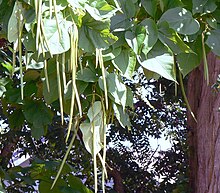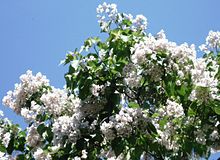Trumpet trees
| Trumpet trees | ||||||||||||
|---|---|---|---|---|---|---|---|---|---|---|---|---|

Common trumpet tree ( Catalpa bignonioides ), flowers |
||||||||||||
| Systematics | ||||||||||||
|
||||||||||||
| Scientific name | ||||||||||||
| Catalpa | ||||||||||||
| Scop. |
The catalpa ( Catalpa ) constitute a genus within the family of Bignoniaceae represents (Bignoniaceae). Due to the elongated capsule fruits they are colloquially known as cigar or bean tree. In the temperate areas of the world, the varieties of some species and hybrids of the decorative trees are used as ornamental trees in parks.
description
Vegetative characteristics
Catalpa species grow as semi-evergreen (four species) or deciduous (six species) trees . Which are arranged opposite or in whorls of the branches leaves are divided into petiole and leaf blade. The leaf blade is usually simple and entire, rarely lobed. The underside of the leaf is dotted purple glandular at the branches of the leaf veins . There are no stipules .
Generative characteristics
The terminal, panicle , umbrella or raceme inflorescences contain bracts and bracts . The hermaphrodite flowers are zygomorphic and five-fold with a double perianth . The five membranous sepals are fused bell-shaped and have two lips or unevenly lobed in the upper area. The five petals are bell-shaped and two-lipped, with the upper lip being two-lobed and the lower lip being three-lobed. The basic color of the petals can be white, pink or creamy yellow (only Catalpa ovata and Catalpa tibetica ), often with different colored areas. At the base of the corolla tube arise only two fertile stamens that do not protrude beyond the corolla . There are three small staminodes . The discus is inconspicuous. Two carpels have become a top permanent, zweifächerigen ovary grown that some ovules contains.
The pendulous, long, pencil-shaped capsule fruits open with two thin flaps and there is a narrow septum. The seeds, standing in several rows, are rounded and winged and have tufts of hair on both ends.
ingredients
All parts of the plant - with the exception of the seeds - are slightly poisonous and contain catalpin (= catalposid) as the main toxin, as well as some related substances.
Others
The caterpillar of Ceratomia catalpae from the subfamily Sphinginae in the family Schwärmer (Sphingidae) is a pest of catalpa species .
The (highly poisonous) angel's trumpets , which are not closely related to the genus Catalpa, are also referred to as the “trumpet tree” . The trumpet flowers ( campsis ) have a similar German trivial name , but like the genus Catalpa they belong to the Bignoniaceae family.
distribution
Of the ten or so catalpa species, four are native to temperate East Asia , four species on the Caribbean islands and two species in North America. In Europe , the species Catalpa bignonioides , which originally comes from North America , is often used as an ornamental plant.
Systematics
The generic name Catalpa was first published in 1777 by Giovanni Antonio Scopoli in Introductio ad Historiam Naturalem , p. 170. Type species is Bignonia catalpa L. , whose valid name is Catalpa ovata G.Don . A synonym for Catalpa Scop. is Macrocatalpa (Griseb.) Britton . The genus Catalpa belongs to the tribe Catalpeae DC. ex Meisn. in the family of Bignoniaceae . Since 2008 the four Macrocatalpa species, all of which are native to the Caribbean islands, have been included in the genus Catalpa .
There are about ten Catalpa species. The genus Catalpa is divided into two sections:
- Macrocatalpa Griseb Section . : These semi-evergreen species are native to the Caribbean islands:
- Catalpa brevipes Urban : It is native to Cuba, Haiti and the Dominican Republic.
- Catalpa longissima (Jacq.) Dum. Cours. : It isnativeto the Caribbean islands of Hispaniola and Jamaica .
- Catalpa macrocarpa Ekman : It is native to the Bahamas and Cuba, Haiti and the Dominican Republic.
- Catalpa purpurea Griseb. : It occurs only in eastern Cuba and on the Île de la Gonâve of Haiti.
- Catalpa Section :
- Common trumpet tree ( Catalpa bignonioides Walter , Syn . : Catalpa syringifolia Sims ): It is native to the southeastern US states of Alabama, Florida, Georgia, Louisiana and Mississippi.
- Catalpa bungei C.A.Mey. (Syn .: Catalpa syringifolia auct.): It is native to the Chinese provinces of Gansu, Hebei, Henan, Hunan, Jiangsu, Shaanxi, Shandong, Shanxi and Zhejiang.
-
Catalpa fargesii Bureau : It is based in the Chinese provinces of Gansu, Guangdong, Guangxi, Guizhou, Hebei, Henan, Hubei, Hunan, Shaanxi, Shandong, Sichuan and Yunnan. A clan here that is seen as a form, but sometimes also as a species:
- Catalpa fargesii forma duclouxii (Don) Gilmour (Syn .: Catalpa duclouxii Dode )
- Catalpa ovata G.Don : It is located in the Chinese provinces of Anhui, Gansu, Hebei, Heilongjiang, Henan, Hubei, Jiangsu, Jilin, Liaoning, Nei Monggol, Ningxia, Qinghai, Shaanxi, Shandong, Shanxi, Sichuan and Xinjiang.
- Magnificent Trumpet Tree ( Catalpa speciosa (Warder) Engelm. ): It is widespread in the USA.
- Catalpa tibetica Forrest : It thrives on slopes and in forests at altitudes between 2400 and 2700 meters only in southeastern Xizang and northwestern Yunnan .
The so-called hybrid trumpet tree was created through crossing :
-
Catalpa × erubescens Carrière (= Catalpa ovata × Catalpa bignonioides , Syn .: Catalpa × hybrida hort. Ex Späth ):
- Catalpa × erubescens nothovar. japonica (Dode) Paclt (Syn .: Catalpa × hybrida var. japonica ( Dode ) Rehder , Syn .: Catalpa japonica Dode )
swell
- Zhi-Yun Zhang & Thawatchai Santisuk: Bignoniaceae in der Flora of China , Volume 18, 1998, p. 215: Catalpa - Online. (Section description and systematics)
- Yasin J. Nasir: Bignoniaceae in the Flora of Pakistan : Catalpa - Online.
Individual evidence
- ↑ Information on the ingredients.
- ↑ LL Hyche: The Catapa Sphinx .
- ^ A b Catalpa in the Germplasm Resources Information Network (GRIN), USDA , ARS , National Genetic Resources Program. National Germplasm Resources Laboratory, Beltsville, Maryland.
- ↑ Richard G. Olmstead, Michelle L. Zjhra, Lúcia G. Lohmann, Susan O. Grose & Andrew J. Eckert: A molecular phylogeny and classification of Bignoniaceae , In: American Journal of Botany , 96, 2009, pp. 1731-1743 : PDF_Online.
- ↑ Jianhua Li: Phylogeny of Catalpa (Bignoniaceae) inferred from sequences of chloroplast ndhF and nuclear ribosomal DNA , In: Journal of Systematics and Evolution 46, 2008, pp. 341-348: PDF_Online.
- ↑ a b c d e f Rafaël Govaerts (Ed.): Catalpa. In: World Checklist of Selected Plant Families (WCSP) - The Board of Trustees of the Royal Botanic Gardens, Kew . Retrieved December 16, 2018.
- ↑ a b c d Zhi-Yun Zhang & Thawatchai Santisuk: Catalpa Scopoli. , Pp. 36-38 - online with the same text as the printed work , In: Wu Zheng-yi, Peter H. Raven, Deyuan Hong (ed.): Flora of China. Volume 18: Bignoniaceae. Science Press and Missouri Botanical Garden Press, Beijing and St. Louis 2010





